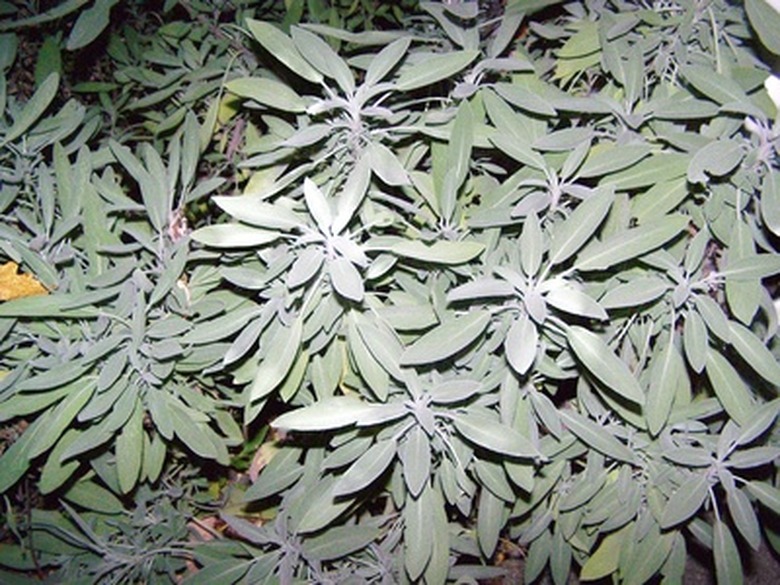Difference Between Salvia Officinalis & Salvia Divinorum
Salvia officinalis and Salvia divinorum are both members of the mint family of plants, but their differences are many. Salvia officinalis is the sage with gray-green leaves that is a common culinary seasoning. Salvia divinorum, native to the northern Sierra Mazateca Mountains in Mexico, has hallucinogenic properties when ingested or smoked.
Saliva Officinalis Description
S. officinalis, garden sage, originates from the Mediterranean region. It is a short-lived, semi-woody shrub with wooly, thick, gray-green or multi-colored oval leaves that are intensely aromatic. The leaves, about 3 inches long, have a slightly bitter fragrance suggesting lemon or rosemary. They have a "pebbly" surface and are arranged in opposing pairs on a square stem; they have conspicuous veins on the underside.
- Salvia officinalis and Salvia divinorum are both members of the mint family of plants, but their differences are many.
S. Officinalis Uses
S. officinalis is an important herb in western cooking. It is used to flavor egg dishes, salads, meats, soups, stews and vegetables as well as to flavor teas and vinegars. It is also as an ingredient in cosmetics, perfumes and soaps. Advocates of alternative medicine assert that extracts of sage are useful in gargles to treat sore throat and in tonics that act as a digestive stimulant; sage extracts are also thought to help digest fatty meats, lower blood sugar in diabetics and treat muscle spasms. These and other medicinal properties of S. officinalis are based on anecdotal evidence and have not been proven by clinical trials.
Saliva Divinorum Description
S. divinorum is a semi-tropical perennial shrub with oval, serrated leaves that grow up to 9 inches long. They have a weak minty aroma. The plant has a distinctive stem that is hollow and square. The plant can grow several yards high. The flowers are white with a purple calyx, that part of the flower which holds the sepals. S. divinorum contains an active hallucinogen, salvinorin. In 2002, researchers discovered that S. divinorum acts on that part of the brain known as the kappa opiate receptor that regulates much of human perception.
- S. officinalis is an important herb in western cooking.
S. Divinorum Uses
Dried S. divinorum leaves can be smoked in a pipe or as a cigarette for mild euphoric effects lasting up to 15 minutes. When the leaves are chewed, the salvinorin enters the mucus of the mouth, producing visual hallucinations. Its leaves are sometimes crushed and mixed with drinks. Extracts of salvinorin are vaporized and inhaled.
Caution
Dr. Jay L. Hoecker of the Mayo Clinic says S. divinorum isn't believed to be addictive but is not been adequately studied in clinical trials. Researchers know little about the long-term effects and risks of using the herb as an hallucinogen. Salvia divinorum is treated as a controlled substance in Delaware, Florida, Illinois, Kansas, Kentucky, Mississippi, Missouri, North Dakota, Ohio, Oklahoma, South Dakota and Virginia. It is illegal if it is intended for human consumption in Louisiana and Tennessee. It is illegal in Australia, Denmark, Belgium, Italy, Germany, Japan, Poland, South Korea, Latvia and Lithuania. A doctor's prescription is needed to import it into Estonia, Finland, Iceland and Norway. Its sale, but not possession, is illegal in Spain.
- Dried S. divinorum leaves can be smoked in a pipe or as a cigarette for mild euphoric effects lasting up to 15 minutes.
- Dr. Jay L. Hoecker of the Mayo Clinic says S. divinorum isn't believed to be addictive but is not been adequately studied in clinical trials.
